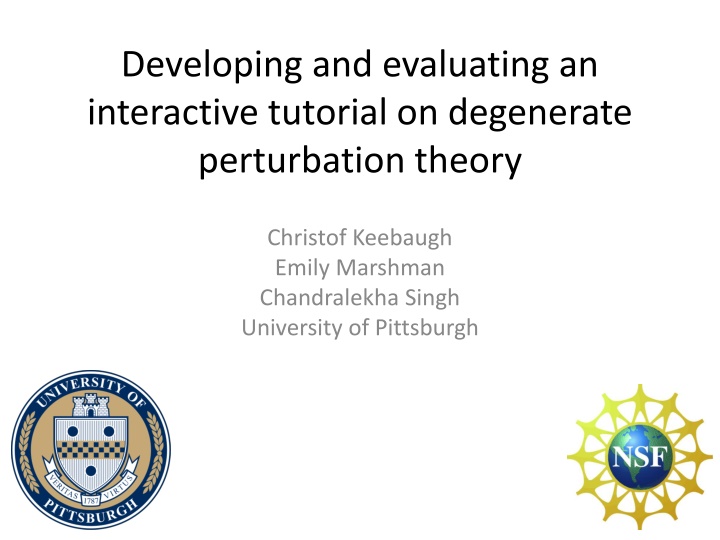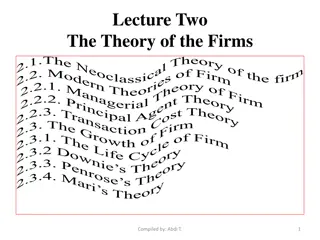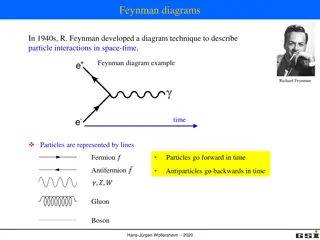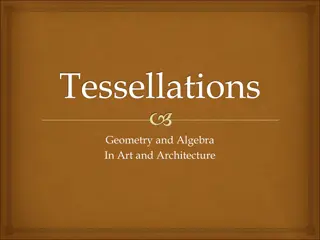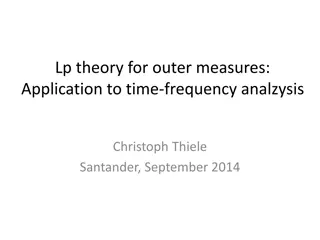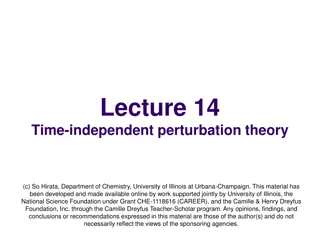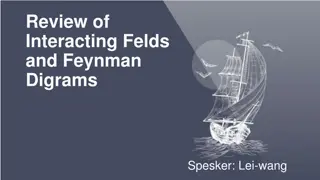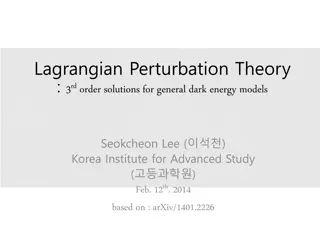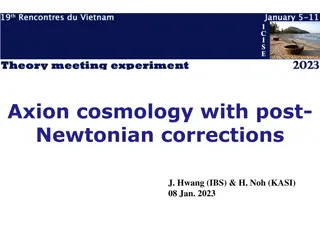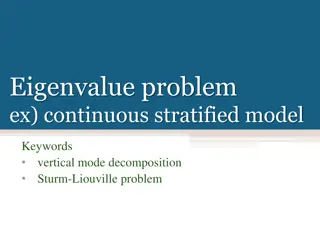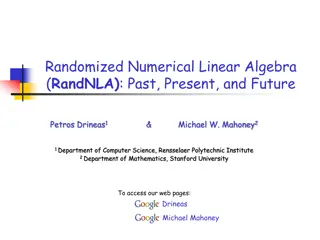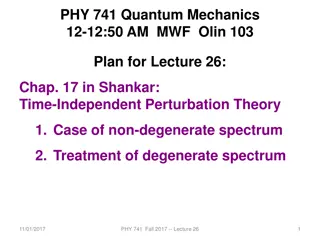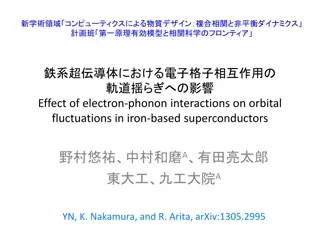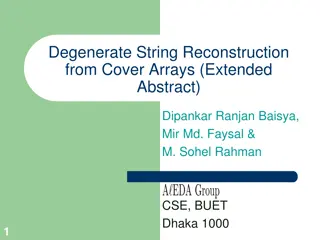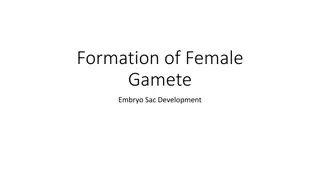Interactive Tutorial on Degenerate Perturbation Theory: QuILT Development and Student Difficulties
Developing an interactive tutorial on Degenerate Perturbation Theory (DPT) to aid students in understanding the challenging synthesis of Quantum Mechanics concepts with Linear Algebra. The tutorial focuses on addressing common student difficulties, such as identifying good bases, diagonalizing matrices, and finding eigenstates. Through QuILT development and analysis of student challenges, this project aims to enhance learning outcomes in DPT.
Download Presentation

Please find below an Image/Link to download the presentation.
The content on the website is provided AS IS for your information and personal use only. It may not be sold, licensed, or shared on other websites without obtaining consent from the author.If you encounter any issues during the download, it is possible that the publisher has removed the file from their server.
You are allowed to download the files provided on this website for personal or commercial use, subject to the condition that they are used lawfully. All files are the property of their respective owners.
The content on the website is provided AS IS for your information and personal use only. It may not be sold, licensed, or shared on other websites without obtaining consent from the author.
E N D
Presentation Transcript
Developing and evaluating an interactive tutorial on degenerate perturbation theory Christof Keebaugh Emily Marshman Chandralekha Singh University of Pittsburgh
Motivation Degenerate Perturbation Theory (DPT) A very challenging subject for students since it requires a synthesis of Quantum Mechanics concepts with Linear Algebra. There have been few studies on student difficulties on this topic. We investigated the student difficulties and developed a tutorial to help the students gain a better understanding of DPT
Perturbation Theory ? = ?0+ ? The first order corrections are given by 0 ? ?? 1= ?? 0 ?? 0 ? ?? 0 ?? 0 ?? (?? 1= 0 ?? ?? 0) ? ? Here we focus on Degenerate Perturbation Theory (DPT) 5 0 0 and ? = ?0 0 0 4? ?0= ?0 (This is a good basis.) 0 2? 0 0 5 0 4? 0 2? 0 0 1 0 ? 4? 5 0 0 ?0= ?0 and ? = ?0 (This is not a good basis.) ? 2? ? 0 5 0 4? ? 2? 0 0 1
QuILT Development Initial version based on: a cognitive task analysis investigation of student difficulties via exams and quizzes Iterated the version with faculty members and students to ensure that the content and wording was appropriate.
Student Difficulties A. Difficulty identifying ? in the degenerate subspace of ?0given the Hamiltonian ?. Many students incorrectly focused on the diagonal elements of the perturbation ? 0 0 0 2? ? 4? ? 2? 5 0 0 0 5 0 0 0 1 ?0= ?0 and ? = ?0 4?
B. Difficulty identifying whether the originally chosen basis is a good basis Many students had a tendency to focus on either ?0or determining if the basis is good. A good basis consists of a complete set of eigenstates of ?0. ? but not both, when 0 0 0 2? ? 4? ? 2? 5 0 0 0 1 0 0 0 1 ?0= ?0 and ? = ?0 4? ? must be diagonal in the good basis. 0 0 0 2? 0 4? 0 2? 5 0 0 0 1 0 0 0 1 ?0= ?0 and ? = ?0 4? Attempted to diagonalize ? when it is already diagonal in a degenerate subspace of ?0. 0 0 0 2? 0 4? 0 2? 5 0 0 0 1 0 0 0 1 ?0= ?0 and ? = ?0 4?
C. Difficulty finding a good basis if the originally chosen basis is not already a good basis The most common mistake was diagonalizing the entire ? matrix instead of diagonalizing the ? matrix only in the degenerate subspace of ?0. We must find the simultaneous eigenstates of ?0and ? . 0 0 0 2? 0 4? 0 2? 5 0 0 0 1 0 0 0 1 ?0= ?0 and ? = ?0 4? Some students struggled with the fact that ? should be diagonalized in the degenerate subspace of ?0while keeping ?0diagonal. We cannot diagonalize a part of ? , we must diagonalize the whole thing.
Preliminary Evaluation 1. Consider the unperturbed Hamiltonian 3 0 0 0 3 0 0 0 7 ?0= ?0 . (a.) Write an example of a perturbing Hamiltonian, ? , such that the basis used to represent ?0in matrix form (above) is a good basis for ? . Use ? as a small parameter. ? 0 2? 0 3? 0 2? 0 3? ? = ?0 Graduate Students (N=19) Undergraduate Students (N=11) Pre (%) Post (%) G (%) g Pre (%) Post (%) G (%) g Retention (%) 67.5 88.2 +20.7 0.64 23.1 100 +76.9 1.00 97.8
1. Consider the unperturbed Hamiltonian 3 0 0 0 3 0 0 0 7 ?0= ?0 . (b.) Write an example of a perturbing Hamiltonian, ? , such that the basis used to represent ?0in matrix form (above) is a not good basis for ? . Use ? as a small parameter. ? 4? 2? 4? 3? 0 2? 0 3? ? = ?0 Graduate Students (N=19) Undergraduate Students (N=11) Pre (%) Post (%) G (%) g Pre (%) Post (%) G (%) g Retention (%) 51.3 73.7 +22.4 0.46 15.4 100 +84.6 1.00 91.0
5 0 0 4? 0 1 + 6? 2. Given ? = ?0+ ? = ?0 1 4? 0 4? with ? 1, determine the first order corrections to the energies. You must show your work. 0 0 0 4? 0 6? 5 0 0 0 1 0 0 0 1 ?0= ?0 and ? = ?0 4? 0 4? Graduate Students (N=19) Undergraduate Students (N=11) Pre (%) Post (%) G (%) g Pre (%) Post (%) G (%) g 30.0 94.8 +64.8 0.93 32.3 100 +67.7 1.00
2 ? ? ? 2 ? ? ? 3 3. Given ? = ?0+ ? = ?0 with ? 1, determine the first order corrections to the energies. You must show your work. 2 0 0 0 2 0 0 0 3 0 ? ? ? 0 ? ? ? 0 ?0= ?0 and ? = ?0 Graduate Students (N=19) Undergraduate Students (N=11) Pre (%) Post (%) G (%) g Pre (%) Post (%) G (%) g 11.7 86.0 +74.3 0.84 2.6 100 +97.4 1.00
Summary Students have many common difficulties with DPT. We developed and evaluated a research- based tutorial to help students develop a solid grasp of DPT. Preliminary evaluations from undergraduate and graduate classes are encouraging.
